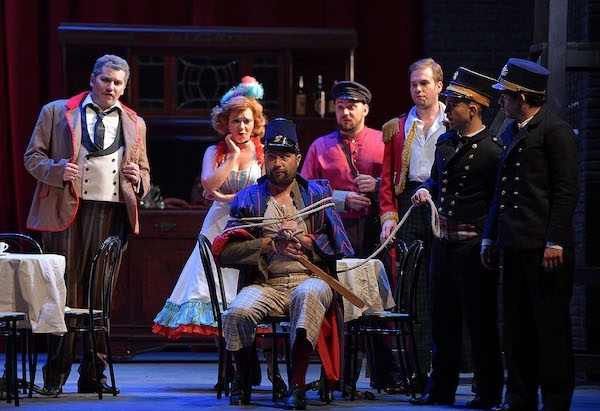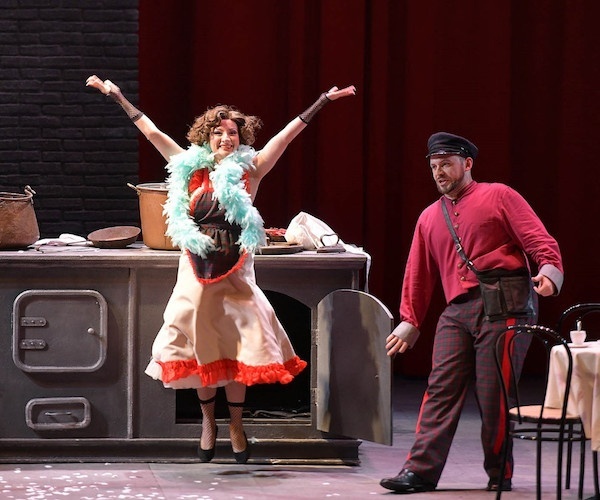Opera CD Review: Spontini’s Wacky Comic Opera, in Which Nothing Is as It Seems
By Ralph P. Locke
The world-premiere CD recording of Le metamorfosi de Pasquale shows a playful side of a composer admired by Wagner and others for grandly tragic works.
Gaspare Spontini: Le Metamorfosi de Pasquale, o sia tutto è illusione nel mondo
Carolina Lippo (Lisetta), Michela Antenucci (Costanza), Antonio Garés (the Marquis), Davide Bartolucci (Frontino), Baurzhan Anderzhanov (Pasquale). G. Rossini Symphony Orchestra, cond. Giuseppe Montesano. Dynamic 7836.02 [2 CDs] 84 minutes
To purchase, click here.

Opera isn’t a single genre. It can be several often very different ones, even in a given time and place and from the same composer. We may feel we know “Mozart the opera composer” from Don Giovanni or The Magic Flute yet be baffled by Idomeneo, a work relying more heavily on techniques from Italian opera seria and even from Gluckian tragédie lyrique.
My experience with Gaspare Spontini’s The Metamorphoses of Pasquale: or, Everything in the World Is an Illusion (first performed in Venice, 1802) was sort of the reverse: I know somewhat well two grandly scaled and sonorously orchestrated tragic works from his subsequent years in Paris: La vestale (which Maria Callas and Franco Corelli brought back from obscurity in a famous live recording from 1954) and Olimpie (which received a brilliant and powerful new recording last year on the Bru Zane label — see my review here). And suddenly here comes along an example of Spontini’s first phase as an opera composer, namely a shortish Italian farsa full of bustling activity and silliness. I loved every minute of it, even as it kept making me think of other people’s operas that were similar in intent: e.g., Rossini’s early farsa La cambiale di matrimonio.
We are lucky that the opera survives at all. Spontini’s many operas written in his native Italy were long thought lost (OxfordMusicOnline still thinks so), but in recent years the manuscripts have begun to show up in private collections, notably in a Belgian castle that once belonged to the Dukes of Ursel and is now owned by the Province of Antwerp and open to the public. A critical edition was prepared by Federico Agostinelli, whose booklet essays explain how he resolved various problems. For example, the overture was missing, so we hear a rather spiffy one that Spontini used in several other operas.
Much in Le metamorfosi looks forward to Rossini. Spontini’s librettist, Giuseppe Foppa, would in fact write libretti for several Rossini comic operas. But Spontini venerated Mozart, which perhaps explains why I hear a number of similarities to the latter’s comic operas.
The plot is built around five main characters: Costanza, a baron’s daughter (soprano), and the Marquis (tenor; they end up marrying), the servants Lisetta and Frontino (soprano and baritone; they likewise marry); and Pasquale, a wiseguy who has come back to town to claim Lisetta but is bested along the way by Frontino, who, like Figaro in the famous operas by Mozart and Rossini, repeatedly figures out what needs to be done next and by or to whom.
The opera’s title refers to the two successive disguises that Frontino has the self-important Pasquale put on: first the Marquis’s coat, then female clothing. Frontino also makes himself the ally of the audience by reporting to us a duel that the Marquis and the Cavaliere (who had been promised the hand of Costanza in marriage) are fighting offstage.
There is one aria for each of the four lovers, plus Pasquale, who of course at least claims to love Lisetta, though he seems to think of her more as a possession that he once, absentmindedly, left behind. The five arias are on the short side but usually contain several sections in contrasting tempos. The duets and larger ensembles tend to be longer and often propel the plot along, not least by means of artful modulations and quasi-developmental passages.

A scene from the Pergolesi Spontini Festival production of Le metamorfosi de Pasquale. Photo: courtesy of the artist.
The opera has two soprano and two bass-baritone roles plus a bass (the Baron, Costanza’s father), but only one tenor. Thus, the duets and larger ensembles often involve a low male voice, or even two. The two “noble” lovers (Costanza and the Marquis) are given a fair amount of coloratura; the “lower” characters get some quick proto-Rossinian “patter” including much word repetition (“tocca tocca tocca”). The Marquis’s aria has a delightful woodwinds-plus-horns accompaniment, reminiscent of the male duet-serenade “Secondate, aurette amiche” in Mozart’s Così fan tutte. Liquid melodies for solo woodwinds in several arias particularly reminded me of Mozart, and there is nothing in the orchestral writing that points to the sometimes aggressively full textures of Olimpie or other operas that Spontini wrote for Paris and Berlin.
The performances are delightful, and as accurate as one might expect from a recording made at a single staged performance, presumably without any patch sessions. Carolina Lippo’s tone is at times a bit impure and her coloratura a bit labored, something I did not notice in the wonderful world-premiere recording of Nicola De Giosa’s Don Checco, made three years earlier (see my review at OperaToday.net). But she acts wonderfully with the voice, as do all the others.
Most of the singers are Italian-born, which helps. The Marquis is Antonio Garés, from Spain; he sings neatly but needs to work on his Italian S’s. (“Lisetta” becomes “Lissetta”). Baurzhan Anderzhanov is from Kazakhstan and studied in Italy. I found him capable but not outstanding in Rossini’s Eduardo e Cristina (review here). In this very different opera, though, he sounds like a native-born basso buffo italiano: more sonorous than many representatives of the type, and (gratifyingly) he does not exaggerate for effect.

A scene from the Pergolesi Spontini Festival production of Le metamorfosi de Pasquale. Photo: courtesy of the artist.
I sense from the photos in the booklet that Lippo and Anderzhanov were particularly fun to watch on stage. I wish I had been at the performance, which took place in 2018 at the annual Pergolesi Spontini Festival. (The festival occurs in Jesi, which is located in the Italian Marches, near the Adriatic. Their website mentions nothing at all for 2020; I hope that they will return after the pandemic recedes. A trailer for the festival performance is on YouTube, but with execrable sound quality.)
There is also a DVD of a production (more or less the same, to judge from the sets and costumes) that took place the same year at Teatro La Fenice in Venice. It features the renowned Irina Dubrovskaya as Lisetta. It seems worth hunting down, to judge by a report at Operawire.com by someone who attended a performance. I just peeked at long excerpts from it on YouTube — oddly, the excerpts are out of order — and was delighted to see the work acted out with panache. The singing was on more or less the same good but not exalted level as on this CD from the Jesi festival; I had thought it might be more consistently strong, given the starry reputation of the Venice opera house.
In short, Le Metamorfosi is a marvelously effective and amusing one-act opera that would suit college opera workshops splendidly. It could also enrich the repertory of professional companies, especially ones that play in small- to medium-sized halls (such as Gil Rose’s Boston-based Odyssey Opera). Think of it as Spontini’s answer (more than a century earlier) to Puccini’s Gianni Schicchi. It’s a delight, especially in this lively, accomplished performance.
Some applause and laughter. Libretto and excellent essays, all in Italian and in largely understandable English. (If you subscribe to Naxos Music Library, you can download the booklet for free.) But Dynamic should have put track numbers in the (otherwise fine) plot synopsis and should have indicated, in the tracklist, which track contains recitatives, an aria, etc.
Ralph P. Locke is emeritus professor of musicology at the University of Rochester’s Eastman School of Music. Six of his articles have won the ASCAP-Deems Taylor Award for excellence in writing about music. His most recent two books are Musical Exoticism: Images and Reflections and Music and the Exotic from the Renaissance to Mozart (both Cambridge University Press). Both are now available in paperback; the second is also available as an e-book. He contributes to American Record Guide and to the online arts-magazines NewYorkArts.net, OperaToday.com, and The Boston Musical Intelligencer. His articles have appeared in major scholarly journals, in OxfordMusicOnline (Grove Dictionary), and in the program books of major opera houses, e.g., Santa Fe (New Mexico), Wexford (Ireland), Glyndebourne, Covent Garden, Bilbao, and the Bavarian State Opera (Munich).
Tagged: Dynamic, Gaspare Spontini, Le Metamorfosi de Pasquale, Ralph Locke
